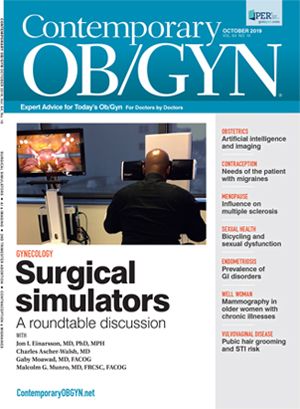AI: Coming to a clinical scenario near you
As artificial intelligence increases its presence in medicine, ob/gyns are welcoming the technology with both excitement and trepidation.
©sdecoret - stock.adobe.com

Artificial intelligence (AI) is already all around us in our daily lives. It enables smart phones to sort our pictures based on face recognition algorithms, it helps Google guess what you‘re going to search for the second you start typing and it helps Uber figure out what you are willing to pay for various services.
Improving medicine with AI
AI is also entering medicine. That is, in part, enabled by the large amount of high-resolution digital data that are collected in electronic medical records and from images, genetic screening, and laboratory tests. The other vital component is the ever-increasing capacity of computers to analyze large amounts of data and create a solution on their own, a process called machine learning. Once implemented, machine learning algorithms can continuously improve their performance by using outcomes to improve the fit of the model. These methods have the potential to help with diagnostic accuracy, outcome prediction, cost-effectiveness assessment, and real-time decision-making in surgery.
In case you missed it: Can AI improve accuracy and efficiency of mammography?
In our October issue, Han et al discuss use of AI in ob/gyn ultrasound and its potential there.1 As they point out, AI is especially helpful in image detection and automation. It has the potential to reduce clinician errors and help detect rare anomalies, especially among less skilled providers, thereby reducing clinician variability in terms of performance. AI also has a lot of other potential applications in our field and in all of medicine. A recent systematic review identified nine articles that spanned multiple medical subjects, including retinal diseases, skin cancers, pulmonary nodules, and brain tumors.2 All of these articles compared the performance of clinicians and AI and found a consistent theme. Current AI algorithm development has a diagnostic performance comparable to that of medical experts, especially in image recognition-related fields. This is especially impressive, given how fairly recently AI has been applied to medical decision-making. It seems inevitable that this technology will improve rapidly over the next few years, which should improve accuracy significantly.
The future for ob/gyns
This does not mean that clinicians are not needed anymore. AI is not meant to replace clinicians (at least not yet), but rather, to augment their diagnostic and therapeutic capacity. One of the major concerns for using AI in medicine is the lack of transparency about how decisions are generated and the inherent risk of bias if the training database is skewed. Some recent advances in the field aim to mitigate those risks. For example, some of the newest diagnostic machine learning algorithms are able to create saliency maps, which identify the parts of the image that contributed the most to the diagnosis.
From Dr. Lockwood: Coping in the age of acceleration
These AI-powered modalities will increasingly help physicians in their daily tasks in the clinic and lab and also potentially in the operating room. Because most surgeries are now image-based, i.e., either laparoscopic or robotic, there is ample opportunity to use neural networks and machine learning to identify patterns in how surgeons perform procedures and potentially alert them if they are diverting off course. It seems likely that this technology will be incorporated into surgical suites in the not-so-distant future. The increasing incorporation of AI into medicine has the promise to improve patient care and patient outcomes and it merits careful exploration and study.
References:
- Datkhaeva I, Han CS. Artificial intelligence in ob/gyn ultrasound. Contemp Ob/Gyn. 2019;64(10):XX.
- Shen J, Zhang CJP, Jiang B, et al. Artificial intelligence versus clinicians in disease diagnosis: systematic review. JMIR Med Inform. 2019 Aug 16;7(3):e10010.

